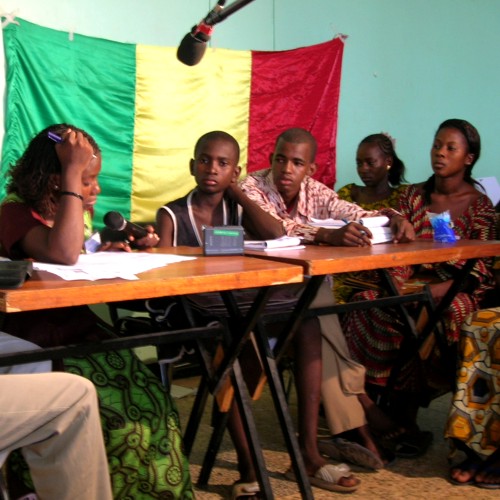In Africa
Children's movements in Africa
One of the largest continental coalitions of children's movements is MAEJT/AMWCY, which was set up in 1994 and now links 27 African countries. The MAEJT/AMWCY formulated 12 rights, the implementation of which is accompanied by continental meetings held every two to three years.
The African Movement of Working Children and Youth was triggered by an action of working children in Senegal on 1 May 1990. There, numerous children had taken part in the May parade with banners and subsequently organised a press conference. They were much approved by the general public. With the support of the NGO Enda Tiers Monde, a meeting of working children and youth (up to 18 years old) from five West African countries (Mali, Ivory Coast, Benin, Burkina Faso and Senegal) was held in Bouaké (Ivory Coast) in July 1994. When the delegates here talked about their experiences and sought solutions to their problems, they came to the conclusion that a joint movement should be launched.
The 12 rights as the basis of the African movement
MAEJT/AMWCY (Mouvement Africain des Enfants et Jeunes Travailleurs/African Movement of Working Children and Youth) subsequently became the much-admired voice of Africa's working children and youth. In order to represent their demands with a uniform programme, they formulated 12 rights:
- The right to be taught a trade;
- The right to not to have to migrate (to remain in our villages);
- The right to securoity when working;
- The right to equitable legal aid (in case of trouble);
- The right to play;
- The right to be listened to;
- he right to light and appropriate work;
- The right to respect;
- The right to rest when sick;
- The right to healthcare;
- The right to learn to read and write;
- The right to self-expression and to form organisations.
Almost 30 years later, these 12 rights are still the common reference point for groups and associations in the respective countries. This is why transnational meetings are held every two or three years to review the extent to which the rights are being met in each country and draw up an action plan for the coming years. In addition, delegates from associations of working children and youth in their country meet every year to discuss the difficulties encountered in enforcing the 12 rights. Initiatives are developed for national and transnational implementation, starting from projects on e.g. health, literacy, education, return to the village, protection from Covid-19, etc.
In addition to strengthening working children and their rights, a priority objective of the movement is to take concrete action against abuse, exploitation and child trafficking. As an alternative to exploitative child labour, several regional associations have initiated so-called "income generating activities" (Les Activités Génératrices des Revenus - AGP). These are activities which help to ensure their own livelihood and the work of their organisation in a humane way. The children and youth and their associations manufacture products or provide services on their own initiative.
With the support of the NGO Enda Tiers Monde, the movement publishes the monthly electronic newsletter "CALAO Express" in French, English and Spanish, which is intended to promote networking throughout Africa and inform the population about the rights and activities of working children and youth. In addition, posters, brochures and learning materials are published in which the local groups find tips and instructions for their daily practice.
Represented in 27 African countries
As of 2015, MAEJT/AMWCY is represented by over 300,000 full members, organised in 380 associations in 27 African countries: Benin, Burkina Faso, Burundi, Democratic Republic of the Congo, Cameroon, Central Africa, Chad, Ethiopia, Gambia, Ghana, Guinea-Bissau, Guinea, Ivory Coast, Kenya, Liberia, Madagascar, Mali, Mauritania, Niger, Nigeria, Rwanda, Senegal, Sierra Leone, Tanzania, Togo, Uganda and Zimbabwe.
MAEJT/AMWCY includes more than 4000 "grassroots groups", local and regional associations of children working either as employees (waiters/waitresses, domestic workers, salesmen...), apprentices (seamstresses, carpenters, welders, mechanics...), self-employed (porters, shoeshine boys, street vendors...), or in the countryside (gardeners, cattle breeders, fishermen...). Sometimes they combine training/study and work. The majority (73%) of the members are children under 18. 57% of the members are girls.
Associations on the ground do not always receive the desired political or legal recognition, and are often met with incomprehension and rejection. But they also find support from many NGOs, churches and sometimes even government agencies.
Since 1996, delegates of the African movement have also participated in meetings of working children and youth in other continents to exchange experiences and develop common strategies.
Links
Updated: 14.12.2020
